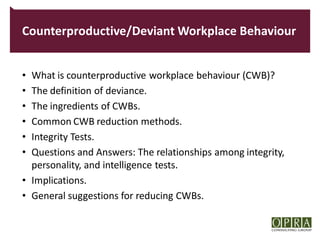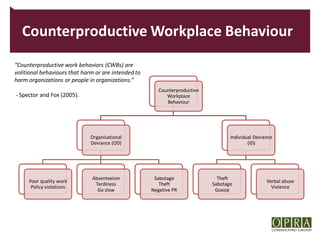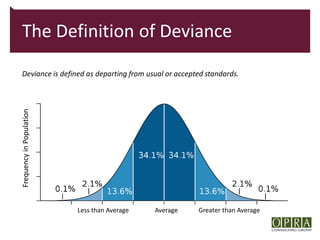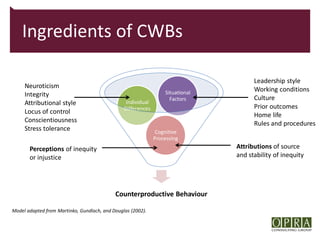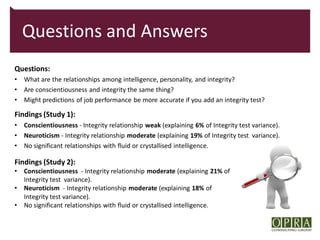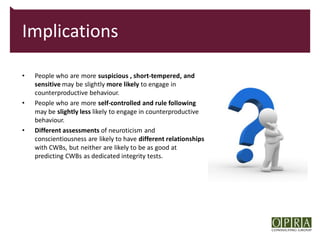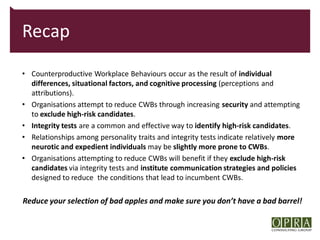Deviant Workplace Behaviour - Workplace Psychology Sig 2012
- 1. Presented by Dr. Paul Wood paul.wood@opragroup.com 021 972 976
- 2. Counterproductive/Deviant Workplace Behaviour • What is counterproductive workplace behaviour (CWB)? • The definition of deviance. • The ingredients of CWBs. • Common CWB reduction methods. • Integrity Tests. • Questions and Answers: The relationships among integrity, personality, and intelligence tests. • Implications. • General suggestions for reducing CWBs.
- 3. Counterproductive Workplace Behaviour “Counterproductive work behaviors (CWBs) are volitional behaviours that harm or are intended to harm organizations or people in organizations.” Counterproductive - Spector and Fox (2005). Workplace Behaviour Organisational Individual Deviance Deviance (OD) (ID) Absenteeism Sabotage Theft Poor quality work Verbal abuse Tardiness Theft Sabotage Policy violations Violence Go slow Negative PR Gossip
- 4. The Definition of Deviance Deviance is defined as departing from usual or accepted standards. Frequency in Population Less than Average Average Greater than Average
- 5. Ingredients of CWBs Leadership style Neuroticism Working conditions Integrity Situational Factors Culture Attributional style Individual Differences Prior outcomes Locus of control Home life Conscientiousness Rules and procedures Stress tolerance Cognitive Processing Perceptions of inequity Attributions of source or injustice and stability of inequity Counterproductive Behaviour Model adapted from Martinko, Gundlach, and Douglas (2002).
- 6. Common CWB Reduction methods Reduction Methods Incumbents Candidates Integrity Previous Security Policy Tests History
- 7. Integrity Tests General Information: • Overt and Covert. • Became popular after 1988 Employee Polygraph Protection Act. • Used to exclude high-risk candidates. • Around 14% of North American companies used integrity tests by 1998. Stanton Survey of Integrity: • Overt and self-report. • Well validated. • Examines work related theft, theft unrelated to work, and company policy violations. • Makes use of rationalisation
- 8. Questions and Answers Questions: • What are the relationships among intelligence, personality, and integrity? • Are conscientiousness and integrity the same thing? • Might predictions of job performance be more accurate if you add an integrity test? Findings (Study 1): • Conscientiousness - Integrity relationship weak (explaining 6% of Integrity test variance). • Neuroticism - Integrity relationship moderate (explaining 19% of Integrity test variance). • No significant relationships with fluid or crystallised intelligence. Findings (Study 2): • Conscientiousness - Integrity relationship moderate (explaining 21% of Integrity test variance). • Neuroticism - Integrity relationship moderate (explaining 18% of Integrity test variance). • No significant relationships with fluid or crystallised intelligence.
- 9. Implications • People who are more suspicious , short-tempered, and sensitive may be slightly more likely to engage in counterproductive behaviour. • People who are more self-controlled and rule following may be slightly less likely to engage in counterproductive behaviour. • Different assessments of neuroticism and conscientiousness are likely to have different relationships with CWBs, but neither are likely to be as good at predicting CWBs as dedicated integrity tests.
- 10. General Suggestions Selection: • Consider the use of Integrity tests to reduce the risk of poor hiring decisions. • Consider your organisational culture/climate and make sure you provide a realistic job preview. General Operation: • Clearly communicate the causes of undesirable outcomes, and their temporary nature. • Clearly communicate what constitutes acceptable /unacceptable behaviours. • Establish more communication channels for employees to express needs and concerns – be seen to act on those concerns!
- 11. Recap • Counterproductive Workplace Behaviours occur as the result of individual differences, situational factors, and cognitive processing (perceptions and attributions). • Organisations attempt to reduce CWBs through increasing security and attempting to exclude high-risk candidates. • Integrity tests are a common and effective way to identify high-risk candidates. • Relationships among personality traits and integrity tests indicate relatively more neurotic and expedient individuals may be slightly more prone to CWBs. • Organisations attempting to reduce CWBs will benefit if they exclude high-risk candidates via integrity tests and institute communication strategies and policies designed to reduce the conditions that lead to incumbent CWBs. Reduce your selection of bad apples and make sure you don’t have a bad barrel!

